Global Business Management Report
VerifiedAdded on 2020/02/23
|15
|3878
|48
Report
AI Summary
This report analyzes the international business expansion of CHEERS, an Australian crafts beer company, which aims to enter the Brazilian market due to market saturation in Australia. It evaluates the opportunities and risks in both Brazil and India, ultimately selecting Brazil for expansion. The report discusses various market entry strategies, justifying the choice of franchising as the preferred method for entering the Brazilian market. The analysis highlights Brazil's political stability, growing middle class, and favorable tax structure, while also addressing potential risks such as corruption and economic inequality.
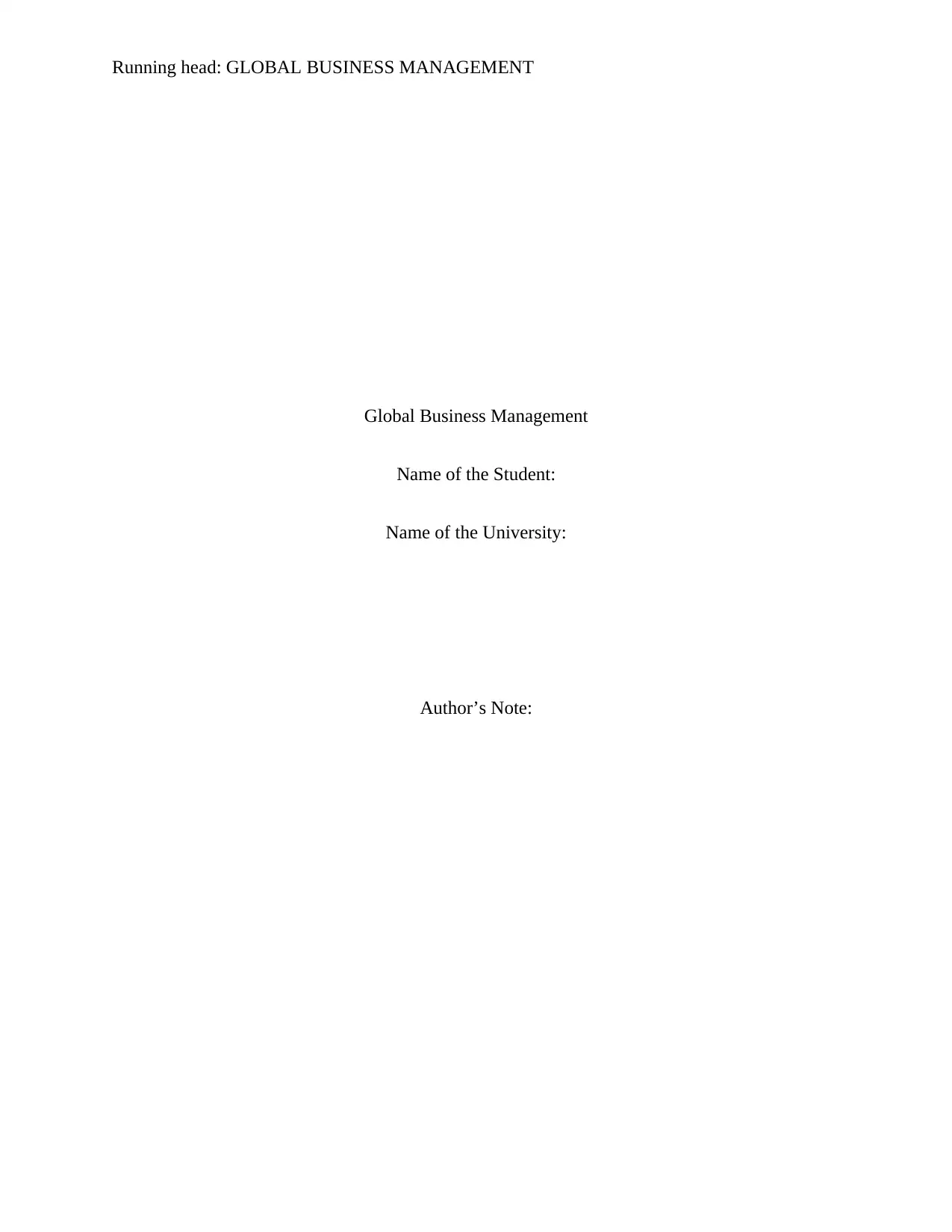
Running head: GLOBAL BUSINESS MANAGEMENT
Global Business Management
Name of the Student:
Name of the University:
Author’s Note:
Global Business Management
Name of the Student:
Name of the University:
Author’s Note:
Paraphrase This Document
Need a fresh take? Get an instant paraphrase of this document with our AI Paraphraser
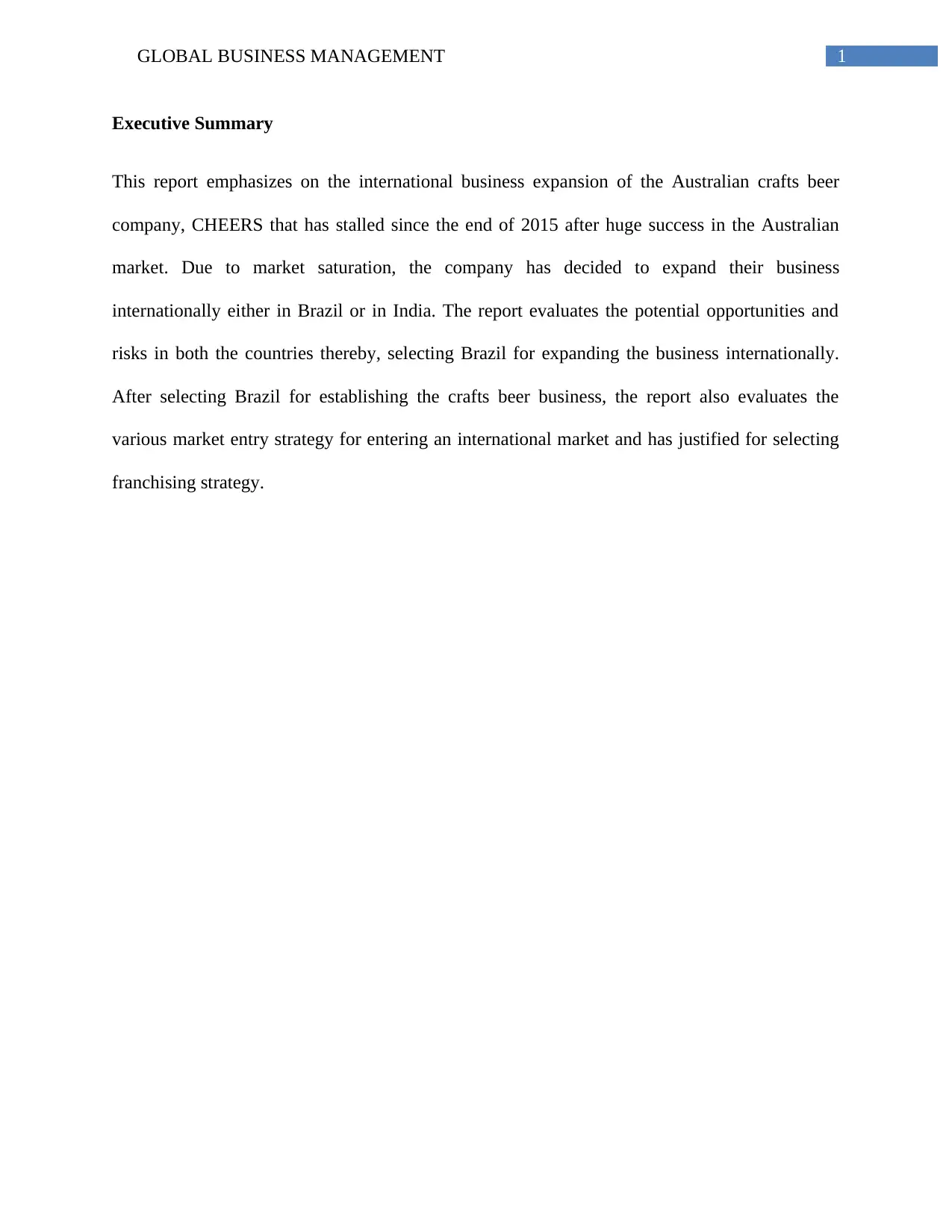
1GLOBAL BUSINESS MANAGEMENT
Executive Summary
This report emphasizes on the international business expansion of the Australian crafts beer
company, CHEERS that has stalled since the end of 2015 after huge success in the Australian
market. Due to market saturation, the company has decided to expand their business
internationally either in Brazil or in India. The report evaluates the potential opportunities and
risks in both the countries thereby, selecting Brazil for expanding the business internationally.
After selecting Brazil for establishing the crafts beer business, the report also evaluates the
various market entry strategy for entering an international market and has justified for selecting
franchising strategy.
Executive Summary
This report emphasizes on the international business expansion of the Australian crafts beer
company, CHEERS that has stalled since the end of 2015 after huge success in the Australian
market. Due to market saturation, the company has decided to expand their business
internationally either in Brazil or in India. The report evaluates the potential opportunities and
risks in both the countries thereby, selecting Brazil for expanding the business internationally.
After selecting Brazil for establishing the crafts beer business, the report also evaluates the
various market entry strategy for entering an international market and has justified for selecting
franchising strategy.
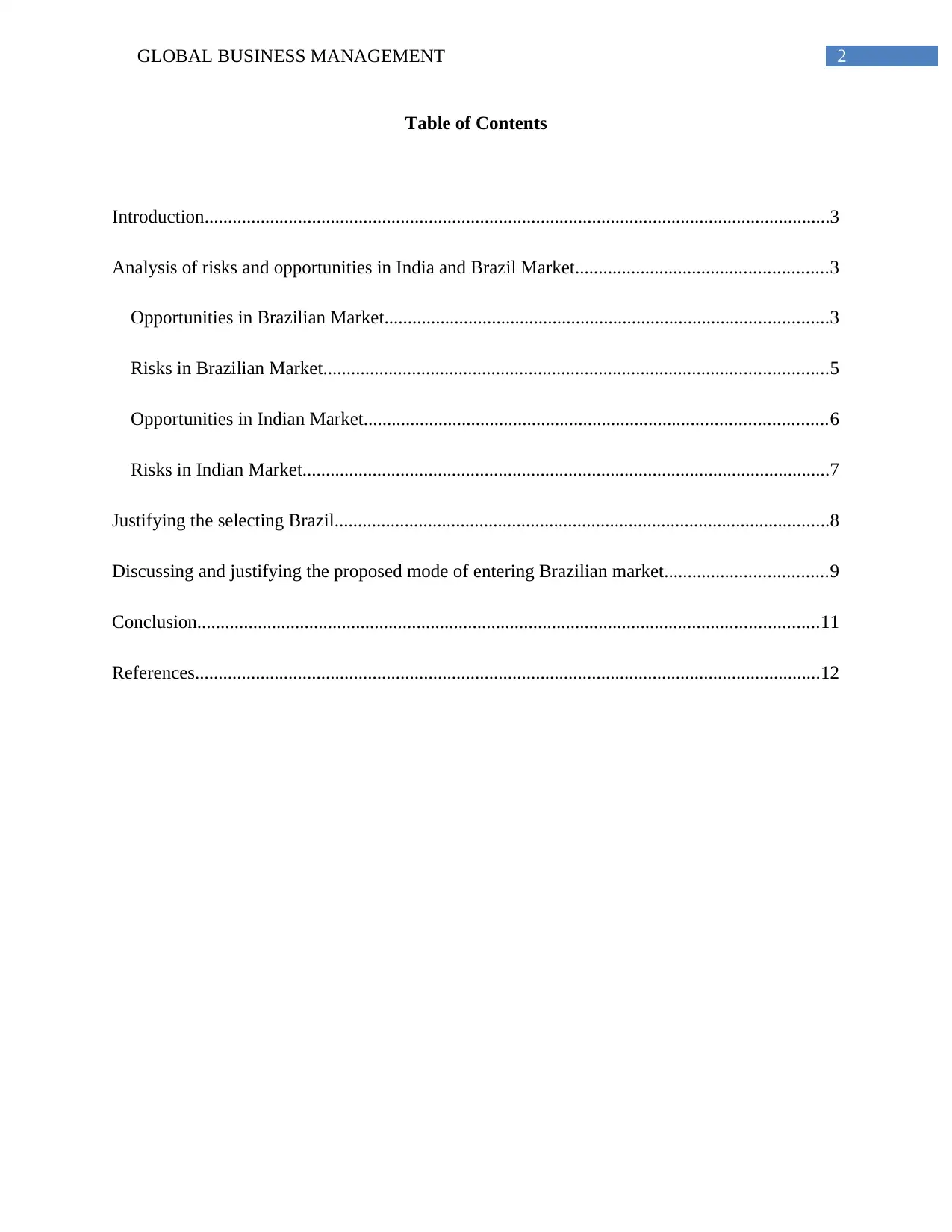
2GLOBAL BUSINESS MANAGEMENT
Table of Contents
Introduction......................................................................................................................................3
Analysis of risks and opportunities in India and Brazil Market......................................................3
Opportunities in Brazilian Market...............................................................................................3
Risks in Brazilian Market............................................................................................................5
Opportunities in Indian Market...................................................................................................6
Risks in Indian Market.................................................................................................................7
Justifying the selecting Brazil..........................................................................................................8
Discussing and justifying the proposed mode of entering Brazilian market...................................9
Conclusion.....................................................................................................................................11
References......................................................................................................................................12
Table of Contents
Introduction......................................................................................................................................3
Analysis of risks and opportunities in India and Brazil Market......................................................3
Opportunities in Brazilian Market...............................................................................................3
Risks in Brazilian Market............................................................................................................5
Opportunities in Indian Market...................................................................................................6
Risks in Indian Market.................................................................................................................7
Justifying the selecting Brazil..........................................................................................................8
Discussing and justifying the proposed mode of entering Brazilian market...................................9
Conclusion.....................................................................................................................................11
References......................................................................................................................................12
⊘ This is a preview!⊘
Do you want full access?
Subscribe today to unlock all pages.

Trusted by 1+ million students worldwide
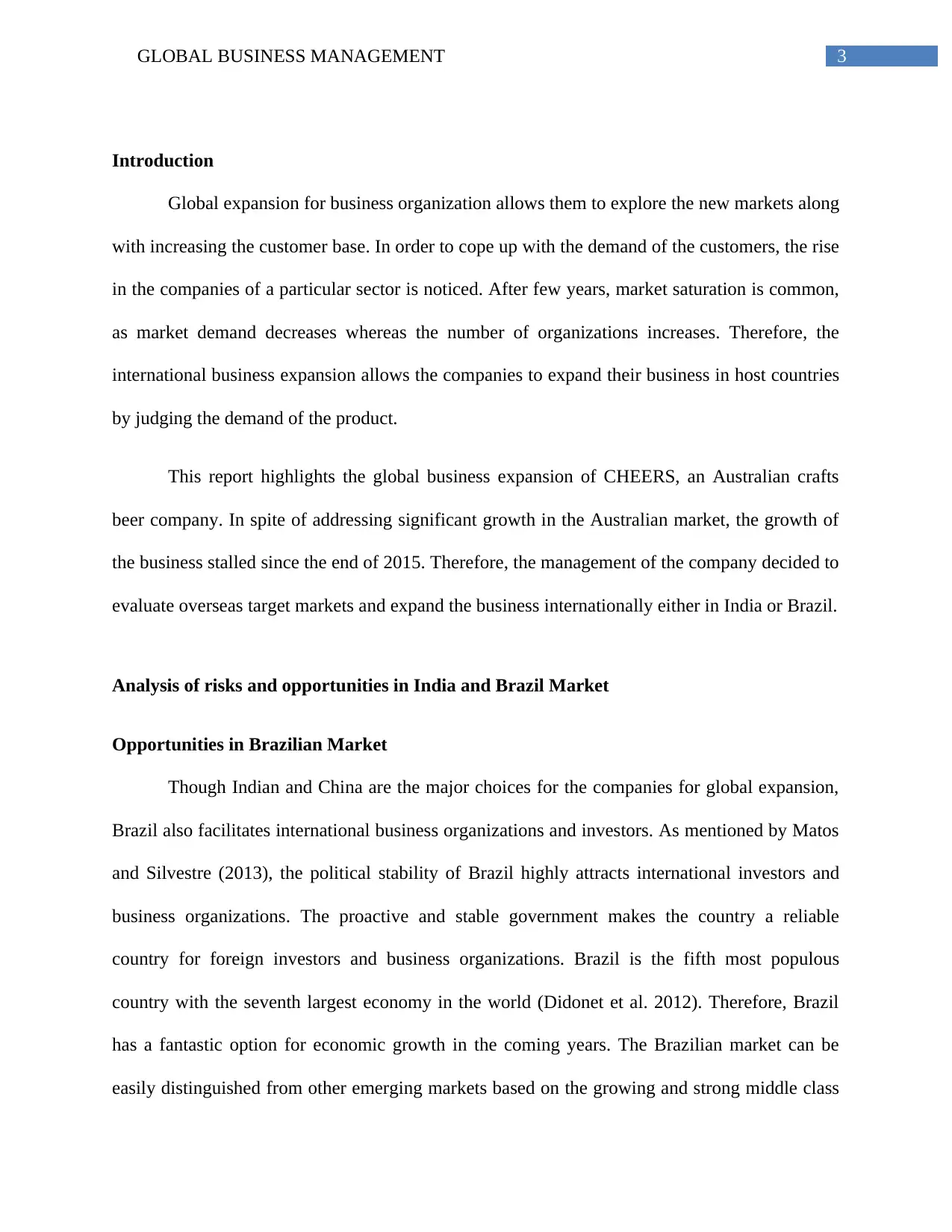
3GLOBAL BUSINESS MANAGEMENT
Introduction
Global expansion for business organization allows them to explore the new markets along
with increasing the customer base. In order to cope up with the demand of the customers, the rise
in the companies of a particular sector is noticed. After few years, market saturation is common,
as market demand decreases whereas the number of organizations increases. Therefore, the
international business expansion allows the companies to expand their business in host countries
by judging the demand of the product.
This report highlights the global business expansion of CHEERS, an Australian crafts
beer company. In spite of addressing significant growth in the Australian market, the growth of
the business stalled since the end of 2015. Therefore, the management of the company decided to
evaluate overseas target markets and expand the business internationally either in India or Brazil.
Analysis of risks and opportunities in India and Brazil Market
Opportunities in Brazilian Market
Though Indian and China are the major choices for the companies for global expansion,
Brazil also facilitates international business organizations and investors. As mentioned by Matos
and Silvestre (2013), the political stability of Brazil highly attracts international investors and
business organizations. The proactive and stable government makes the country a reliable
country for foreign investors and business organizations. Brazil is the fifth most populous
country with the seventh largest economy in the world (Didonet et al. 2012). Therefore, Brazil
has a fantastic option for economic growth in the coming years. The Brazilian market can be
easily distinguished from other emerging markets based on the growing and strong middle class
Introduction
Global expansion for business organization allows them to explore the new markets along
with increasing the customer base. In order to cope up with the demand of the customers, the rise
in the companies of a particular sector is noticed. After few years, market saturation is common,
as market demand decreases whereas the number of organizations increases. Therefore, the
international business expansion allows the companies to expand their business in host countries
by judging the demand of the product.
This report highlights the global business expansion of CHEERS, an Australian crafts
beer company. In spite of addressing significant growth in the Australian market, the growth of
the business stalled since the end of 2015. Therefore, the management of the company decided to
evaluate overseas target markets and expand the business internationally either in India or Brazil.
Analysis of risks and opportunities in India and Brazil Market
Opportunities in Brazilian Market
Though Indian and China are the major choices for the companies for global expansion,
Brazil also facilitates international business organizations and investors. As mentioned by Matos
and Silvestre (2013), the political stability of Brazil highly attracts international investors and
business organizations. The proactive and stable government makes the country a reliable
country for foreign investors and business organizations. Brazil is the fifth most populous
country with the seventh largest economy in the world (Didonet et al. 2012). Therefore, Brazil
has a fantastic option for economic growth in the coming years. The Brazilian market can be
easily distinguished from other emerging markets based on the growing and strong middle class
Paraphrase This Document
Need a fresh take? Get an instant paraphrase of this document with our AI Paraphraser
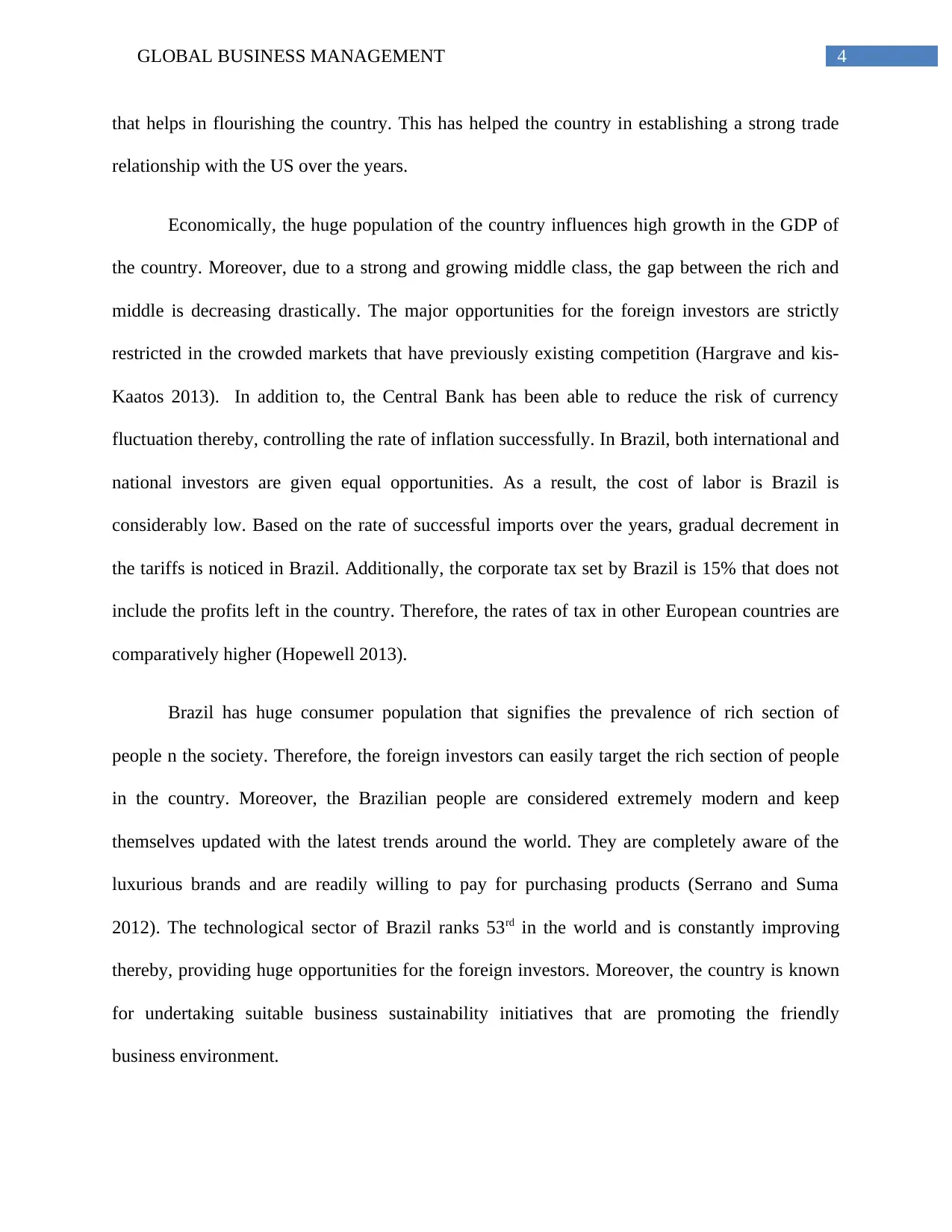
4GLOBAL BUSINESS MANAGEMENT
that helps in flourishing the country. This has helped the country in establishing a strong trade
relationship with the US over the years.
Economically, the huge population of the country influences high growth in the GDP of
the country. Moreover, due to a strong and growing middle class, the gap between the rich and
middle is decreasing drastically. The major opportunities for the foreign investors are strictly
restricted in the crowded markets that have previously existing competition (Hargrave and kis-
Kaatos 2013). In addition to, the Central Bank has been able to reduce the risk of currency
fluctuation thereby, controlling the rate of inflation successfully. In Brazil, both international and
national investors are given equal opportunities. As a result, the cost of labor is Brazil is
considerably low. Based on the rate of successful imports over the years, gradual decrement in
the tariffs is noticed in Brazil. Additionally, the corporate tax set by Brazil is 15% that does not
include the profits left in the country. Therefore, the rates of tax in other European countries are
comparatively higher (Hopewell 2013).
Brazil has huge consumer population that signifies the prevalence of rich section of
people n the society. Therefore, the foreign investors can easily target the rich section of people
in the country. Moreover, the Brazilian people are considered extremely modern and keep
themselves updated with the latest trends around the world. They are completely aware of the
luxurious brands and are readily willing to pay for purchasing products (Serrano and Suma
2012). The technological sector of Brazil ranks 53rd in the world and is constantly improving
thereby, providing huge opportunities for the foreign investors. Moreover, the country is known
for undertaking suitable business sustainability initiatives that are promoting the friendly
business environment.
that helps in flourishing the country. This has helped the country in establishing a strong trade
relationship with the US over the years.
Economically, the huge population of the country influences high growth in the GDP of
the country. Moreover, due to a strong and growing middle class, the gap between the rich and
middle is decreasing drastically. The major opportunities for the foreign investors are strictly
restricted in the crowded markets that have previously existing competition (Hargrave and kis-
Kaatos 2013). In addition to, the Central Bank has been able to reduce the risk of currency
fluctuation thereby, controlling the rate of inflation successfully. In Brazil, both international and
national investors are given equal opportunities. As a result, the cost of labor is Brazil is
considerably low. Based on the rate of successful imports over the years, gradual decrement in
the tariffs is noticed in Brazil. Additionally, the corporate tax set by Brazil is 15% that does not
include the profits left in the country. Therefore, the rates of tax in other European countries are
comparatively higher (Hopewell 2013).
Brazil has huge consumer population that signifies the prevalence of rich section of
people n the society. Therefore, the foreign investors can easily target the rich section of people
in the country. Moreover, the Brazilian people are considered extremely modern and keep
themselves updated with the latest trends around the world. They are completely aware of the
luxurious brands and are readily willing to pay for purchasing products (Serrano and Suma
2012). The technological sector of Brazil ranks 53rd in the world and is constantly improving
thereby, providing huge opportunities for the foreign investors. Moreover, the country is known
for undertaking suitable business sustainability initiatives that are promoting the friendly
business environment.
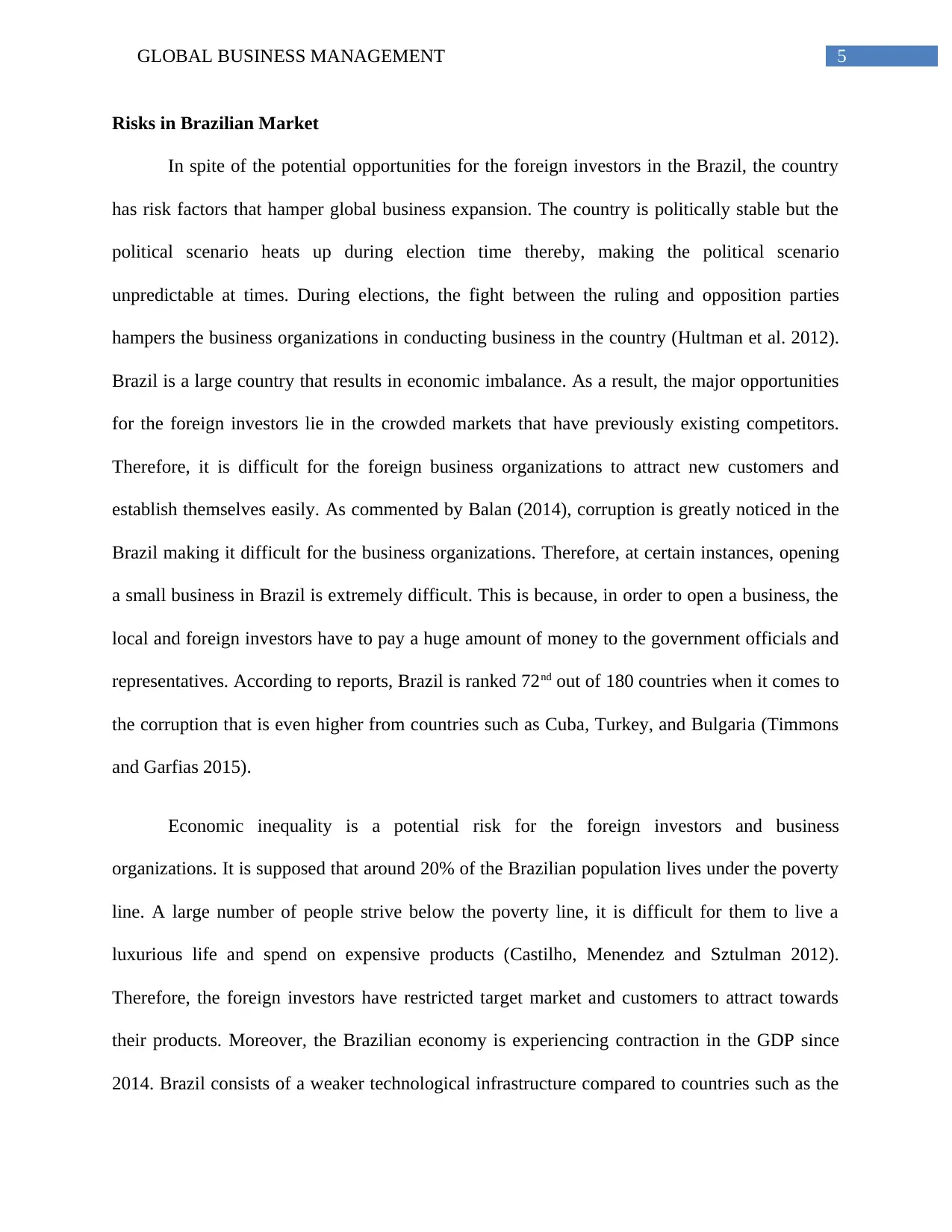
5GLOBAL BUSINESS MANAGEMENT
Risks in Brazilian Market
In spite of the potential opportunities for the foreign investors in the Brazil, the country
has risk factors that hamper global business expansion. The country is politically stable but the
political scenario heats up during election time thereby, making the political scenario
unpredictable at times. During elections, the fight between the ruling and opposition parties
hampers the business organizations in conducting business in the country (Hultman et al. 2012).
Brazil is a large country that results in economic imbalance. As a result, the major opportunities
for the foreign investors lie in the crowded markets that have previously existing competitors.
Therefore, it is difficult for the foreign business organizations to attract new customers and
establish themselves easily. As commented by Balan (2014), corruption is greatly noticed in the
Brazil making it difficult for the business organizations. Therefore, at certain instances, opening
a small business in Brazil is extremely difficult. This is because, in order to open a business, the
local and foreign investors have to pay a huge amount of money to the government officials and
representatives. According to reports, Brazil is ranked 72nd out of 180 countries when it comes to
the corruption that is even higher from countries such as Cuba, Turkey, and Bulgaria (Timmons
and Garfias 2015).
Economic inequality is a potential risk for the foreign investors and business
organizations. It is supposed that around 20% of the Brazilian population lives under the poverty
line. A large number of people strive below the poverty line, it is difficult for them to live a
luxurious life and spend on expensive products (Castilho, Menendez and Sztulman 2012).
Therefore, the foreign investors have restricted target market and customers to attract towards
their products. Moreover, the Brazilian economy is experiencing contraction in the GDP since
2014. Brazil consists of a weaker technological infrastructure compared to countries such as the
Risks in Brazilian Market
In spite of the potential opportunities for the foreign investors in the Brazil, the country
has risk factors that hamper global business expansion. The country is politically stable but the
political scenario heats up during election time thereby, making the political scenario
unpredictable at times. During elections, the fight between the ruling and opposition parties
hampers the business organizations in conducting business in the country (Hultman et al. 2012).
Brazil is a large country that results in economic imbalance. As a result, the major opportunities
for the foreign investors lie in the crowded markets that have previously existing competitors.
Therefore, it is difficult for the foreign business organizations to attract new customers and
establish themselves easily. As commented by Balan (2014), corruption is greatly noticed in the
Brazil making it difficult for the business organizations. Therefore, at certain instances, opening
a small business in Brazil is extremely difficult. This is because, in order to open a business, the
local and foreign investors have to pay a huge amount of money to the government officials and
representatives. According to reports, Brazil is ranked 72nd out of 180 countries when it comes to
the corruption that is even higher from countries such as Cuba, Turkey, and Bulgaria (Timmons
and Garfias 2015).
Economic inequality is a potential risk for the foreign investors and business
organizations. It is supposed that around 20% of the Brazilian population lives under the poverty
line. A large number of people strive below the poverty line, it is difficult for them to live a
luxurious life and spend on expensive products (Castilho, Menendez and Sztulman 2012).
Therefore, the foreign investors have restricted target market and customers to attract towards
their products. Moreover, the Brazilian economy is experiencing contraction in the GDP since
2014. Brazil consists of a weaker technological infrastructure compared to countries such as the
⊘ This is a preview!⊘
Do you want full access?
Subscribe today to unlock all pages.

Trusted by 1+ million students worldwide
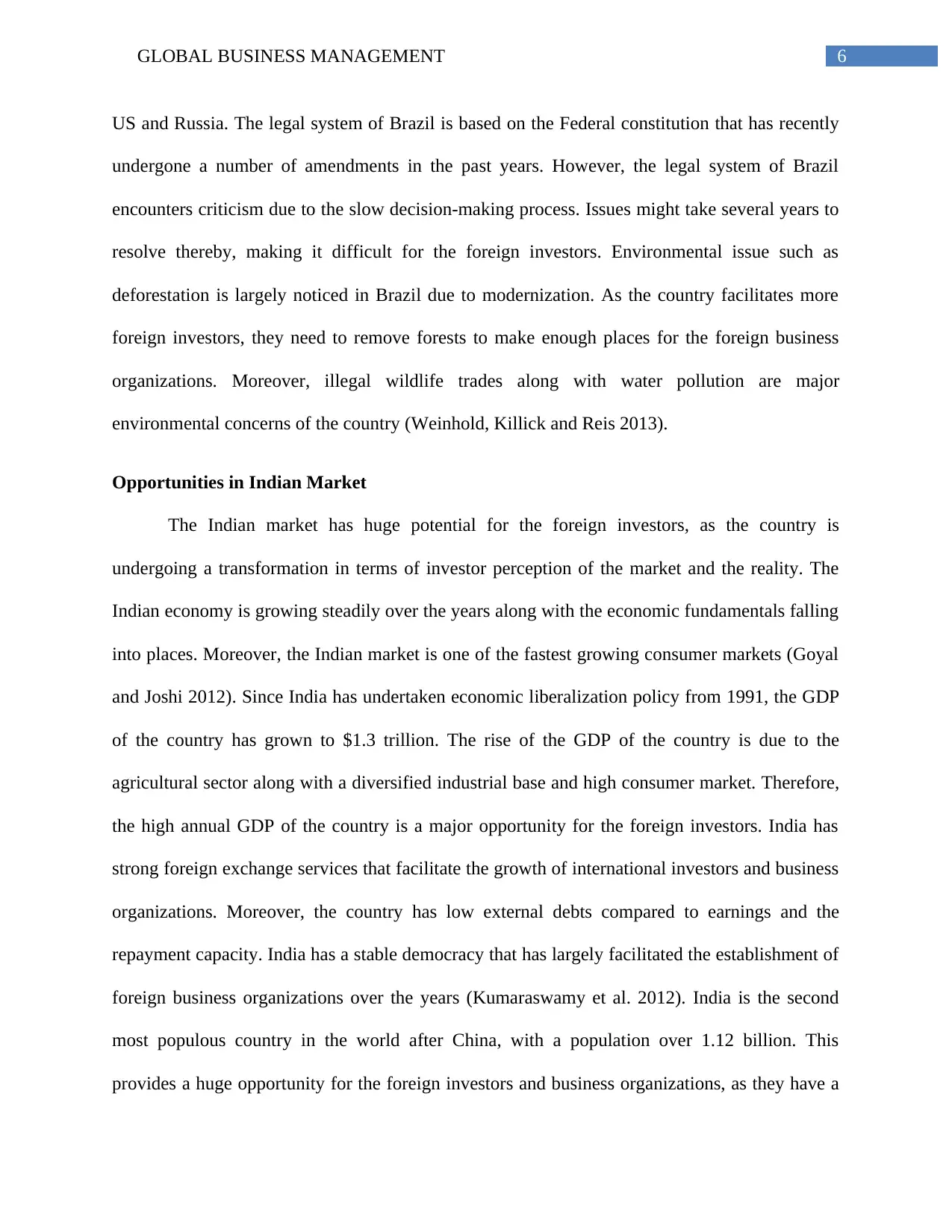
6GLOBAL BUSINESS MANAGEMENT
US and Russia. The legal system of Brazil is based on the Federal constitution that has recently
undergone a number of amendments in the past years. However, the legal system of Brazil
encounters criticism due to the slow decision-making process. Issues might take several years to
resolve thereby, making it difficult for the foreign investors. Environmental issue such as
deforestation is largely noticed in Brazil due to modernization. As the country facilitates more
foreign investors, they need to remove forests to make enough places for the foreign business
organizations. Moreover, illegal wildlife trades along with water pollution are major
environmental concerns of the country (Weinhold, Killick and Reis 2013).
Opportunities in Indian Market
The Indian market has huge potential for the foreign investors, as the country is
undergoing a transformation in terms of investor perception of the market and the reality. The
Indian economy is growing steadily over the years along with the economic fundamentals falling
into places. Moreover, the Indian market is one of the fastest growing consumer markets (Goyal
and Joshi 2012). Since India has undertaken economic liberalization policy from 1991, the GDP
of the country has grown to $1.3 trillion. The rise of the GDP of the country is due to the
agricultural sector along with a diversified industrial base and high consumer market. Therefore,
the high annual GDP of the country is a major opportunity for the foreign investors. India has
strong foreign exchange services that facilitate the growth of international investors and business
organizations. Moreover, the country has low external debts compared to earnings and the
repayment capacity. India has a stable democracy that has largely facilitated the establishment of
foreign business organizations over the years (Kumaraswamy et al. 2012). India is the second
most populous country in the world after China, with a population over 1.12 billion. This
provides a huge opportunity for the foreign investors and business organizations, as they have a
US and Russia. The legal system of Brazil is based on the Federal constitution that has recently
undergone a number of amendments in the past years. However, the legal system of Brazil
encounters criticism due to the slow decision-making process. Issues might take several years to
resolve thereby, making it difficult for the foreign investors. Environmental issue such as
deforestation is largely noticed in Brazil due to modernization. As the country facilitates more
foreign investors, they need to remove forests to make enough places for the foreign business
organizations. Moreover, illegal wildlife trades along with water pollution are major
environmental concerns of the country (Weinhold, Killick and Reis 2013).
Opportunities in Indian Market
The Indian market has huge potential for the foreign investors, as the country is
undergoing a transformation in terms of investor perception of the market and the reality. The
Indian economy is growing steadily over the years along with the economic fundamentals falling
into places. Moreover, the Indian market is one of the fastest growing consumer markets (Goyal
and Joshi 2012). Since India has undertaken economic liberalization policy from 1991, the GDP
of the country has grown to $1.3 trillion. The rise of the GDP of the country is due to the
agricultural sector along with a diversified industrial base and high consumer market. Therefore,
the high annual GDP of the country is a major opportunity for the foreign investors. India has
strong foreign exchange services that facilitate the growth of international investors and business
organizations. Moreover, the country has low external debts compared to earnings and the
repayment capacity. India has a stable democracy that has largely facilitated the establishment of
foreign business organizations over the years (Kumaraswamy et al. 2012). India is the second
most populous country in the world after China, with a population over 1.12 billion. This
provides a huge opportunity for the foreign investors and business organizations, as they have a
Paraphrase This Document
Need a fresh take? Get an instant paraphrase of this document with our AI Paraphraser
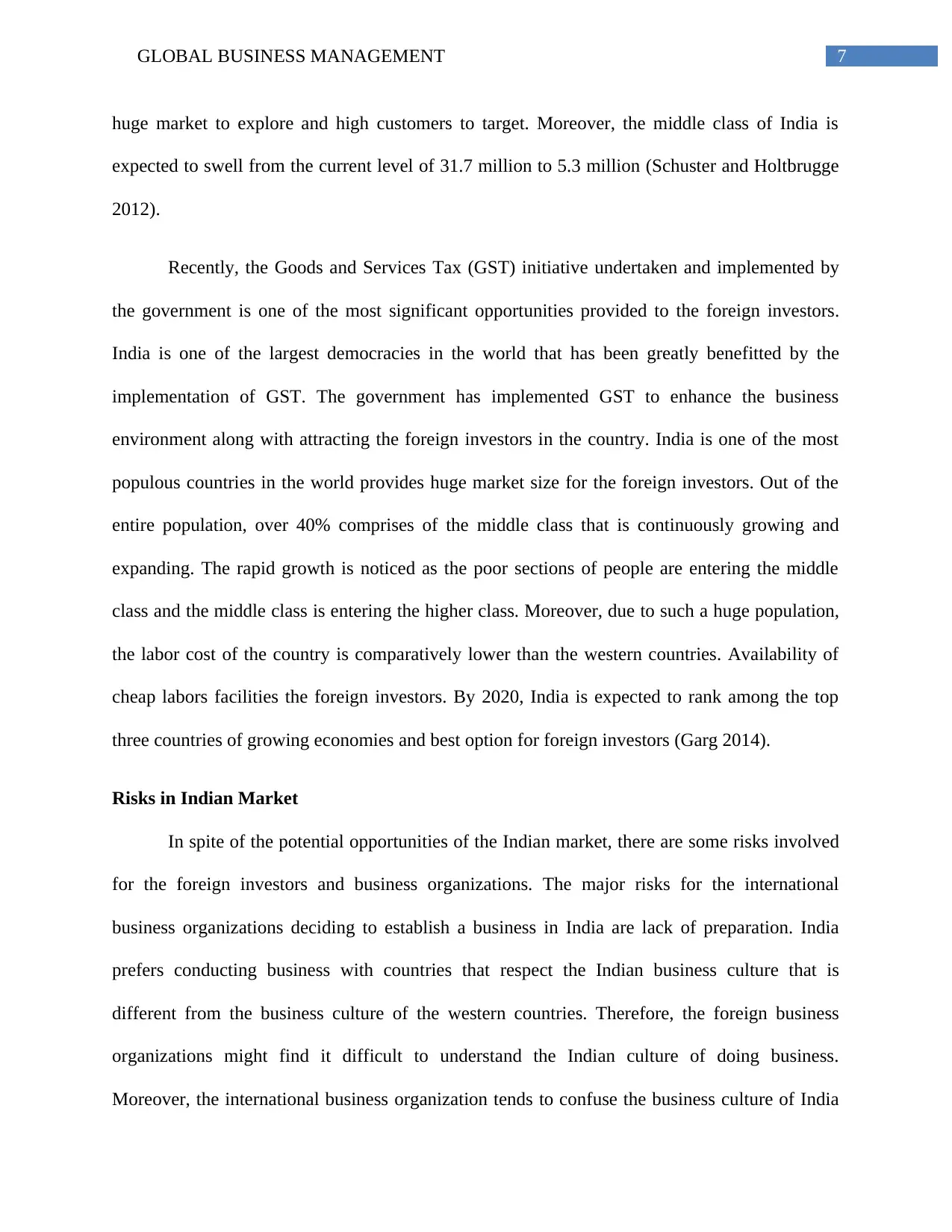
7GLOBAL BUSINESS MANAGEMENT
huge market to explore and high customers to target. Moreover, the middle class of India is
expected to swell from the current level of 31.7 million to 5.3 million (Schuster and Holtbrugge
2012).
Recently, the Goods and Services Tax (GST) initiative undertaken and implemented by
the government is one of the most significant opportunities provided to the foreign investors.
India is one of the largest democracies in the world that has been greatly benefitted by the
implementation of GST. The government has implemented GST to enhance the business
environment along with attracting the foreign investors in the country. India is one of the most
populous countries in the world provides huge market size for the foreign investors. Out of the
entire population, over 40% comprises of the middle class that is continuously growing and
expanding. The rapid growth is noticed as the poor sections of people are entering the middle
class and the middle class is entering the higher class. Moreover, due to such a huge population,
the labor cost of the country is comparatively lower than the western countries. Availability of
cheap labors facilities the foreign investors. By 2020, India is expected to rank among the top
three countries of growing economies and best option for foreign investors (Garg 2014).
Risks in Indian Market
In spite of the potential opportunities of the Indian market, there are some risks involved
for the foreign investors and business organizations. The major risks for the international
business organizations deciding to establish a business in India are lack of preparation. India
prefers conducting business with countries that respect the Indian business culture that is
different from the business culture of the western countries. Therefore, the foreign business
organizations might find it difficult to understand the Indian culture of doing business.
Moreover, the international business organization tends to confuse the business culture of India
huge market to explore and high customers to target. Moreover, the middle class of India is
expected to swell from the current level of 31.7 million to 5.3 million (Schuster and Holtbrugge
2012).
Recently, the Goods and Services Tax (GST) initiative undertaken and implemented by
the government is one of the most significant opportunities provided to the foreign investors.
India is one of the largest democracies in the world that has been greatly benefitted by the
implementation of GST. The government has implemented GST to enhance the business
environment along with attracting the foreign investors in the country. India is one of the most
populous countries in the world provides huge market size for the foreign investors. Out of the
entire population, over 40% comprises of the middle class that is continuously growing and
expanding. The rapid growth is noticed as the poor sections of people are entering the middle
class and the middle class is entering the higher class. Moreover, due to such a huge population,
the labor cost of the country is comparatively lower than the western countries. Availability of
cheap labors facilities the foreign investors. By 2020, India is expected to rank among the top
three countries of growing economies and best option for foreign investors (Garg 2014).
Risks in Indian Market
In spite of the potential opportunities of the Indian market, there are some risks involved
for the foreign investors and business organizations. The major risks for the international
business organizations deciding to establish a business in India are lack of preparation. India
prefers conducting business with countries that respect the Indian business culture that is
different from the business culture of the western countries. Therefore, the foreign business
organizations might find it difficult to understand the Indian culture of doing business.
Moreover, the international business organization tends to confuse the business culture of India
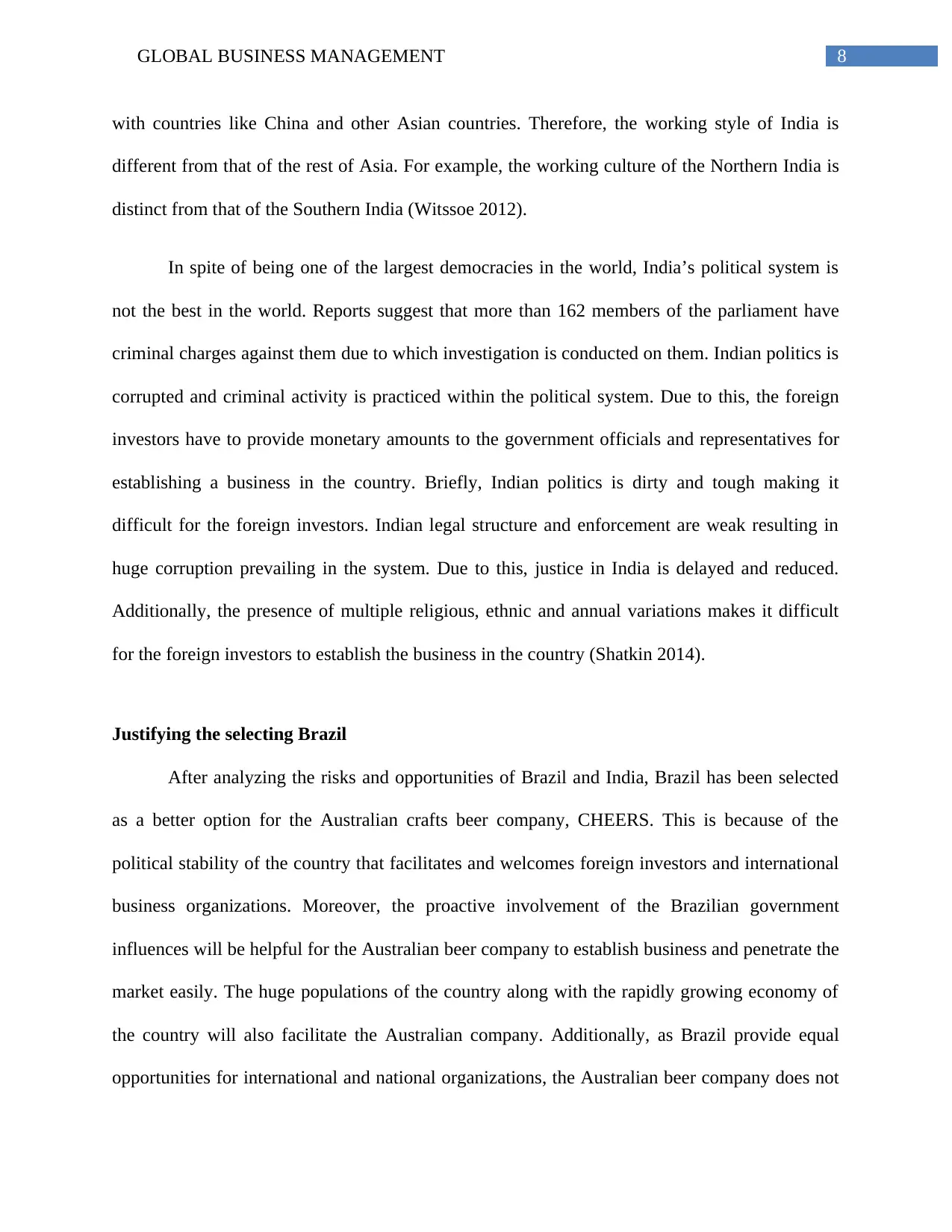
8GLOBAL BUSINESS MANAGEMENT
with countries like China and other Asian countries. Therefore, the working style of India is
different from that of the rest of Asia. For example, the working culture of the Northern India is
distinct from that of the Southern India (Witssoe 2012).
In spite of being one of the largest democracies in the world, India’s political system is
not the best in the world. Reports suggest that more than 162 members of the parliament have
criminal charges against them due to which investigation is conducted on them. Indian politics is
corrupted and criminal activity is practiced within the political system. Due to this, the foreign
investors have to provide monetary amounts to the government officials and representatives for
establishing a business in the country. Briefly, Indian politics is dirty and tough making it
difficult for the foreign investors. Indian legal structure and enforcement are weak resulting in
huge corruption prevailing in the system. Due to this, justice in India is delayed and reduced.
Additionally, the presence of multiple religious, ethnic and annual variations makes it difficult
for the foreign investors to establish the business in the country (Shatkin 2014).
Justifying the selecting Brazil
After analyzing the risks and opportunities of Brazil and India, Brazil has been selected
as a better option for the Australian crafts beer company, CHEERS. This is because of the
political stability of the country that facilitates and welcomes foreign investors and international
business organizations. Moreover, the proactive involvement of the Brazilian government
influences will be helpful for the Australian beer company to establish business and penetrate the
market easily. The huge populations of the country along with the rapidly growing economy of
the country will also facilitate the Australian company. Additionally, as Brazil provide equal
opportunities for international and national organizations, the Australian beer company does not
with countries like China and other Asian countries. Therefore, the working style of India is
different from that of the rest of Asia. For example, the working culture of the Northern India is
distinct from that of the Southern India (Witssoe 2012).
In spite of being one of the largest democracies in the world, India’s political system is
not the best in the world. Reports suggest that more than 162 members of the parliament have
criminal charges against them due to which investigation is conducted on them. Indian politics is
corrupted and criminal activity is practiced within the political system. Due to this, the foreign
investors have to provide monetary amounts to the government officials and representatives for
establishing a business in the country. Briefly, Indian politics is dirty and tough making it
difficult for the foreign investors. Indian legal structure and enforcement are weak resulting in
huge corruption prevailing in the system. Due to this, justice in India is delayed and reduced.
Additionally, the presence of multiple religious, ethnic and annual variations makes it difficult
for the foreign investors to establish the business in the country (Shatkin 2014).
Justifying the selecting Brazil
After analyzing the risks and opportunities of Brazil and India, Brazil has been selected
as a better option for the Australian crafts beer company, CHEERS. This is because of the
political stability of the country that facilitates and welcomes foreign investors and international
business organizations. Moreover, the proactive involvement of the Brazilian government
influences will be helpful for the Australian beer company to establish business and penetrate the
market easily. The huge populations of the country along with the rapidly growing economy of
the country will also facilitate the Australian company. Additionally, as Brazil provide equal
opportunities for international and national organizations, the Australian beer company does not
⊘ This is a preview!⊘
Do you want full access?
Subscribe today to unlock all pages.

Trusted by 1+ million students worldwide
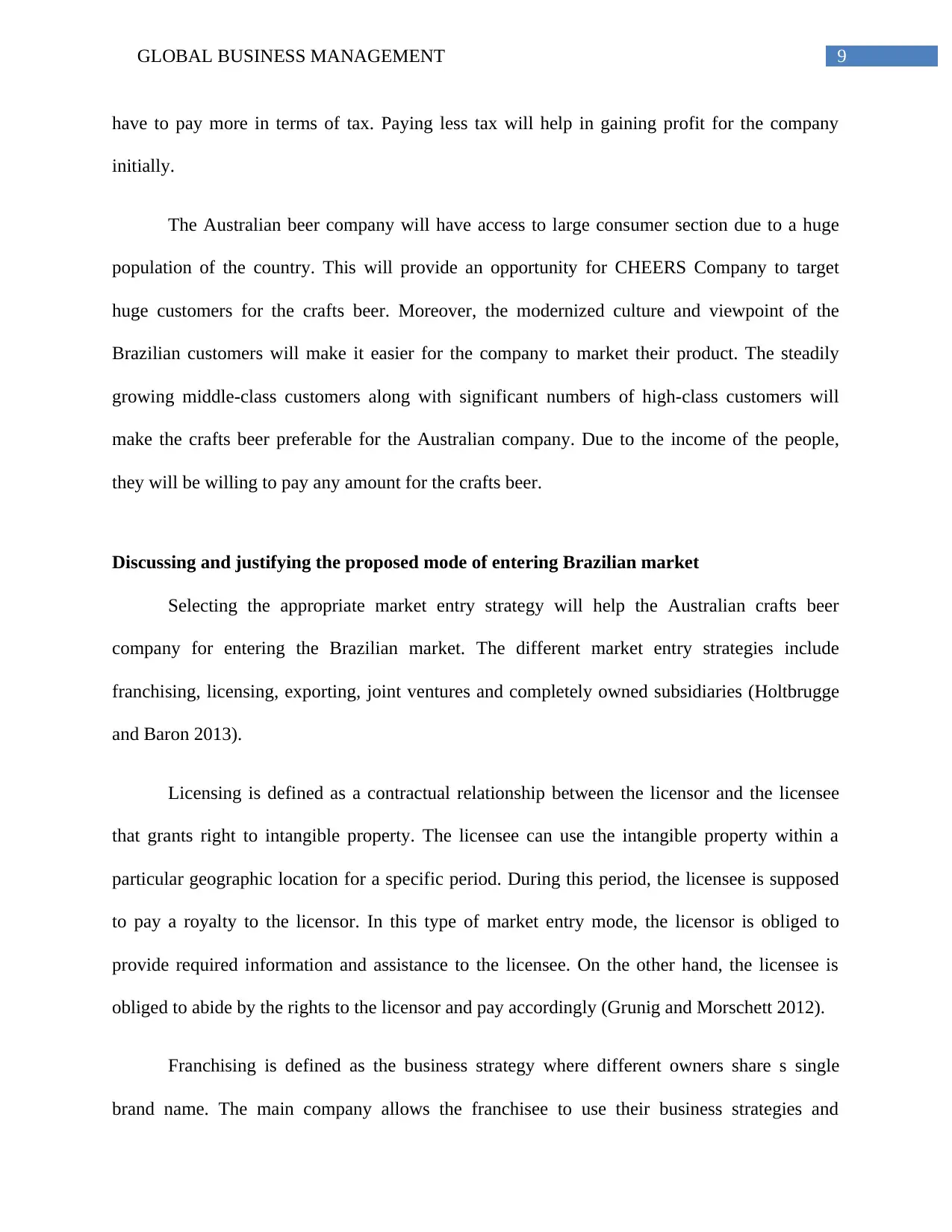
9GLOBAL BUSINESS MANAGEMENT
have to pay more in terms of tax. Paying less tax will help in gaining profit for the company
initially.
The Australian beer company will have access to large consumer section due to a huge
population of the country. This will provide an opportunity for CHEERS Company to target
huge customers for the crafts beer. Moreover, the modernized culture and viewpoint of the
Brazilian customers will make it easier for the company to market their product. The steadily
growing middle-class customers along with significant numbers of high-class customers will
make the crafts beer preferable for the Australian company. Due to the income of the people,
they will be willing to pay any amount for the crafts beer.
Discussing and justifying the proposed mode of entering Brazilian market
Selecting the appropriate market entry strategy will help the Australian crafts beer
company for entering the Brazilian market. The different market entry strategies include
franchising, licensing, exporting, joint ventures and completely owned subsidiaries (Holtbrugge
and Baron 2013).
Licensing is defined as a contractual relationship between the licensor and the licensee
that grants right to intangible property. The licensee can use the intangible property within a
particular geographic location for a specific period. During this period, the licensee is supposed
to pay a royalty to the licensor. In this type of market entry mode, the licensor is obliged to
provide required information and assistance to the licensee. On the other hand, the licensee is
obliged to abide by the rights to the licensor and pay accordingly (Grunig and Morschett 2012).
Franchising is defined as the business strategy where different owners share s single
brand name. The main company allows the franchisee to use their business strategies and
have to pay more in terms of tax. Paying less tax will help in gaining profit for the company
initially.
The Australian beer company will have access to large consumer section due to a huge
population of the country. This will provide an opportunity for CHEERS Company to target
huge customers for the crafts beer. Moreover, the modernized culture and viewpoint of the
Brazilian customers will make it easier for the company to market their product. The steadily
growing middle-class customers along with significant numbers of high-class customers will
make the crafts beer preferable for the Australian company. Due to the income of the people,
they will be willing to pay any amount for the crafts beer.
Discussing and justifying the proposed mode of entering Brazilian market
Selecting the appropriate market entry strategy will help the Australian crafts beer
company for entering the Brazilian market. The different market entry strategies include
franchising, licensing, exporting, joint ventures and completely owned subsidiaries (Holtbrugge
and Baron 2013).
Licensing is defined as a contractual relationship between the licensor and the licensee
that grants right to intangible property. The licensee can use the intangible property within a
particular geographic location for a specific period. During this period, the licensee is supposed
to pay a royalty to the licensor. In this type of market entry mode, the licensor is obliged to
provide required information and assistance to the licensee. On the other hand, the licensee is
obliged to abide by the rights to the licensor and pay accordingly (Grunig and Morschett 2012).
Franchising is defined as the business strategy where different owners share s single
brand name. The main company allows the franchisee to use their business strategies and
Paraphrase This Document
Need a fresh take? Get an instant paraphrase of this document with our AI Paraphraser
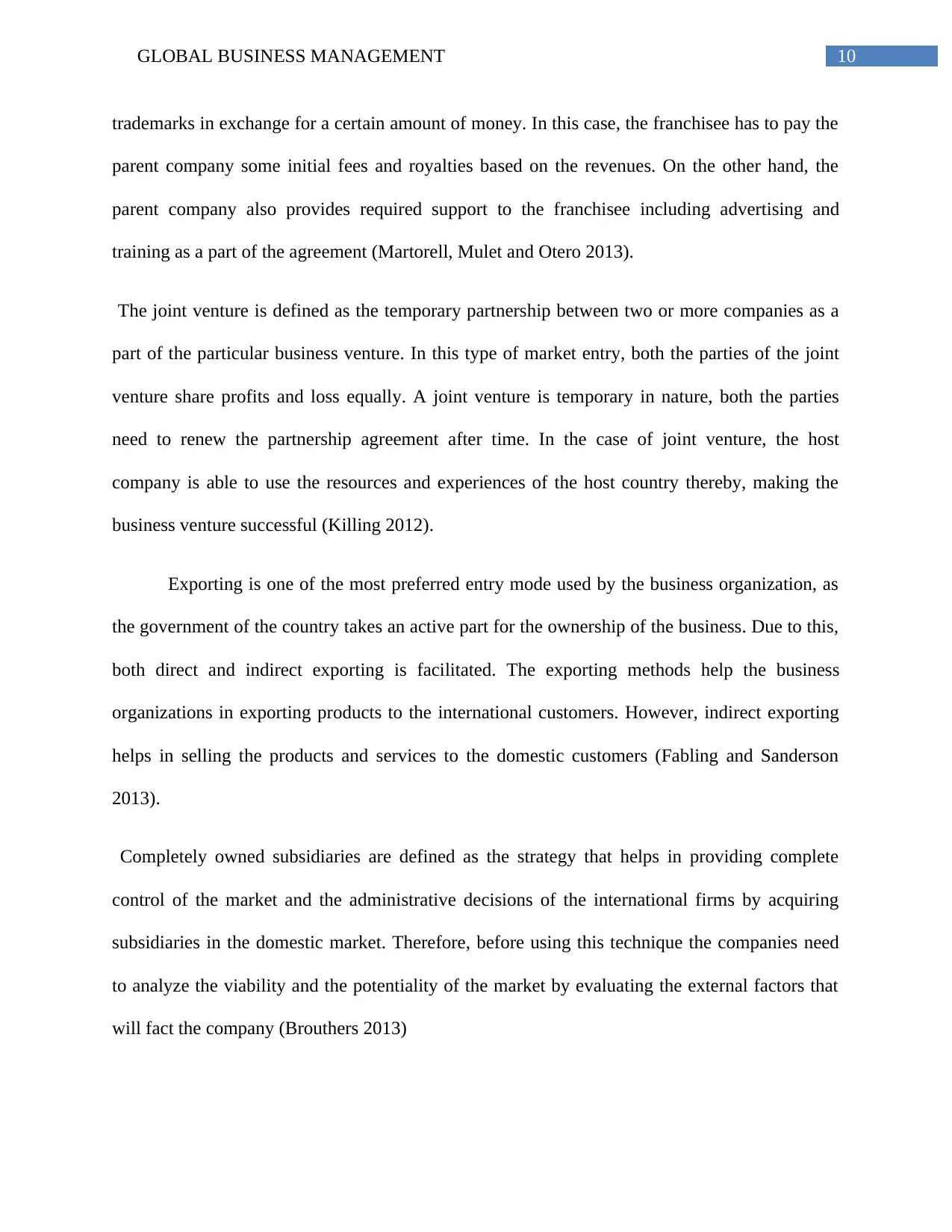
10GLOBAL BUSINESS MANAGEMENT
trademarks in exchange for a certain amount of money. In this case, the franchisee has to pay the
parent company some initial fees and royalties based on the revenues. On the other hand, the
parent company also provides required support to the franchisee including advertising and
training as a part of the agreement (Martorell, Mulet and Otero 2013).
The joint venture is defined as the temporary partnership between two or more companies as a
part of the particular business venture. In this type of market entry, both the parties of the joint
venture share profits and loss equally. A joint venture is temporary in nature, both the parties
need to renew the partnership agreement after time. In the case of joint venture, the host
company is able to use the resources and experiences of the host country thereby, making the
business venture successful (Killing 2012).
Exporting is one of the most preferred entry mode used by the business organization, as
the government of the country takes an active part for the ownership of the business. Due to this,
both direct and indirect exporting is facilitated. The exporting methods help the business
organizations in exporting products to the international customers. However, indirect exporting
helps in selling the products and services to the domestic customers (Fabling and Sanderson
2013).
Completely owned subsidiaries are defined as the strategy that helps in providing complete
control of the market and the administrative decisions of the international firms by acquiring
subsidiaries in the domestic market. Therefore, before using this technique the companies need
to analyze the viability and the potentiality of the market by evaluating the external factors that
will fact the company (Brouthers 2013)
trademarks in exchange for a certain amount of money. In this case, the franchisee has to pay the
parent company some initial fees and royalties based on the revenues. On the other hand, the
parent company also provides required support to the franchisee including advertising and
training as a part of the agreement (Martorell, Mulet and Otero 2013).
The joint venture is defined as the temporary partnership between two or more companies as a
part of the particular business venture. In this type of market entry, both the parties of the joint
venture share profits and loss equally. A joint venture is temporary in nature, both the parties
need to renew the partnership agreement after time. In the case of joint venture, the host
company is able to use the resources and experiences of the host country thereby, making the
business venture successful (Killing 2012).
Exporting is one of the most preferred entry mode used by the business organization, as
the government of the country takes an active part for the ownership of the business. Due to this,
both direct and indirect exporting is facilitated. The exporting methods help the business
organizations in exporting products to the international customers. However, indirect exporting
helps in selling the products and services to the domestic customers (Fabling and Sanderson
2013).
Completely owned subsidiaries are defined as the strategy that helps in providing complete
control of the market and the administrative decisions of the international firms by acquiring
subsidiaries in the domestic market. Therefore, before using this technique the companies need
to analyze the viability and the potentiality of the market by evaluating the external factors that
will fact the company (Brouthers 2013)
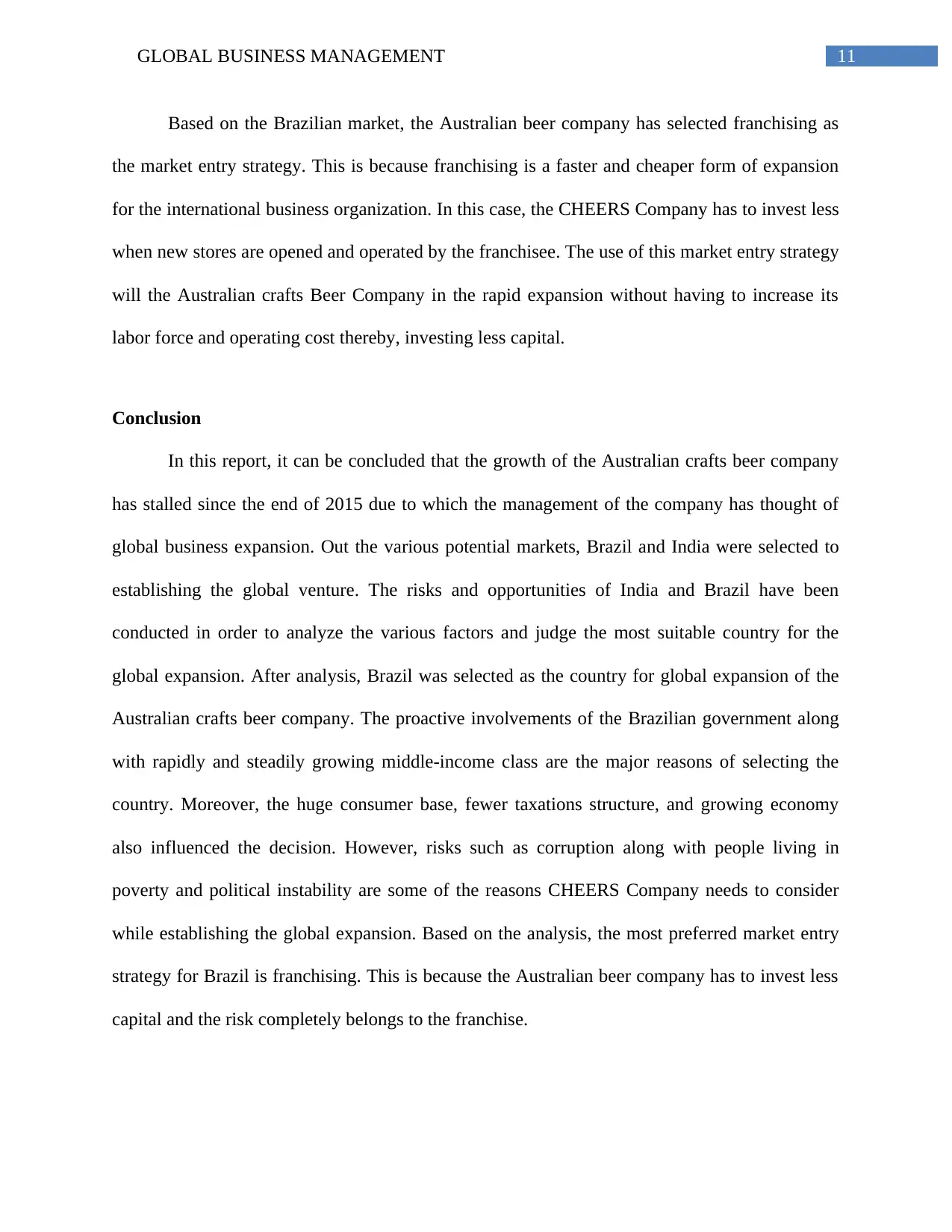
11GLOBAL BUSINESS MANAGEMENT
Based on the Brazilian market, the Australian beer company has selected franchising as
the market entry strategy. This is because franchising is a faster and cheaper form of expansion
for the international business organization. In this case, the CHEERS Company has to invest less
when new stores are opened and operated by the franchisee. The use of this market entry strategy
will the Australian crafts Beer Company in the rapid expansion without having to increase its
labor force and operating cost thereby, investing less capital.
Conclusion
In this report, it can be concluded that the growth of the Australian crafts beer company
has stalled since the end of 2015 due to which the management of the company has thought of
global business expansion. Out the various potential markets, Brazil and India were selected to
establishing the global venture. The risks and opportunities of India and Brazil have been
conducted in order to analyze the various factors and judge the most suitable country for the
global expansion. After analysis, Brazil was selected as the country for global expansion of the
Australian crafts beer company. The proactive involvements of the Brazilian government along
with rapidly and steadily growing middle-income class are the major reasons of selecting the
country. Moreover, the huge consumer base, fewer taxations structure, and growing economy
also influenced the decision. However, risks such as corruption along with people living in
poverty and political instability are some of the reasons CHEERS Company needs to consider
while establishing the global expansion. Based on the analysis, the most preferred market entry
strategy for Brazil is franchising. This is because the Australian beer company has to invest less
capital and the risk completely belongs to the franchise.
Based on the Brazilian market, the Australian beer company has selected franchising as
the market entry strategy. This is because franchising is a faster and cheaper form of expansion
for the international business organization. In this case, the CHEERS Company has to invest less
when new stores are opened and operated by the franchisee. The use of this market entry strategy
will the Australian crafts Beer Company in the rapid expansion without having to increase its
labor force and operating cost thereby, investing less capital.
Conclusion
In this report, it can be concluded that the growth of the Australian crafts beer company
has stalled since the end of 2015 due to which the management of the company has thought of
global business expansion. Out the various potential markets, Brazil and India were selected to
establishing the global venture. The risks and opportunities of India and Brazil have been
conducted in order to analyze the various factors and judge the most suitable country for the
global expansion. After analysis, Brazil was selected as the country for global expansion of the
Australian crafts beer company. The proactive involvements of the Brazilian government along
with rapidly and steadily growing middle-income class are the major reasons of selecting the
country. Moreover, the huge consumer base, fewer taxations structure, and growing economy
also influenced the decision. However, risks such as corruption along with people living in
poverty and political instability are some of the reasons CHEERS Company needs to consider
while establishing the global expansion. Based on the analysis, the most preferred market entry
strategy for Brazil is franchising. This is because the Australian beer company has to invest less
capital and the risk completely belongs to the franchise.
⊘ This is a preview!⊘
Do you want full access?
Subscribe today to unlock all pages.

Trusted by 1+ million students worldwide
1 out of 15
Related Documents
Your All-in-One AI-Powered Toolkit for Academic Success.
+13062052269
info@desklib.com
Available 24*7 on WhatsApp / Email
![[object Object]](/_next/static/media/star-bottom.7253800d.svg)
Unlock your academic potential
Copyright © 2020–2025 A2Z Services. All Rights Reserved. Developed and managed by ZUCOL.





